外研版(2019)选择性必修第四册Unit 4 Everyday economics Period 3 Developing ideas and presenting ideas 课件(共29张)
文档属性
| 名称 | 外研版(2019)选择性必修第四册Unit 4 Everyday economics Period 3 Developing ideas and presenting ideas 课件(共29张) | 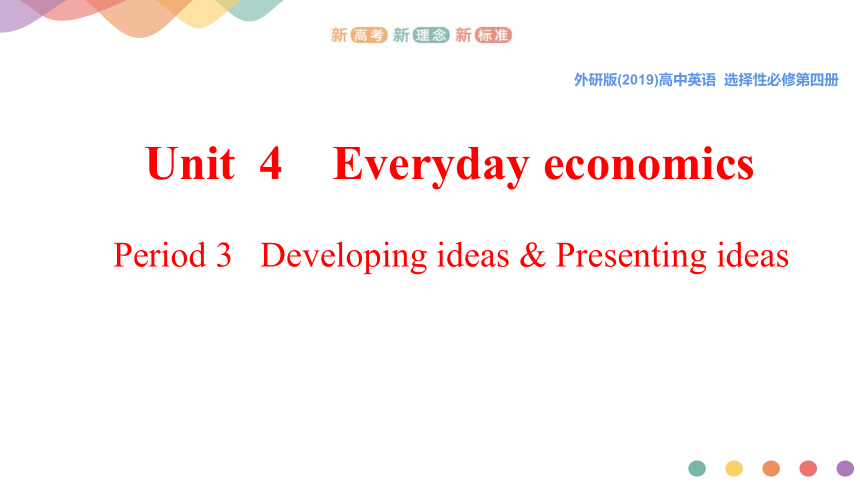 | |
| 格式 | zip | ||
| 文件大小 | 25.7MB | ||
| 资源类型 | 教案 | ||
| 版本资源 | 外研版(2019) | ||
| 科目 | 英语 | ||
| 更新时间 | 2022-08-29 21:10:35 | ||
图片预览

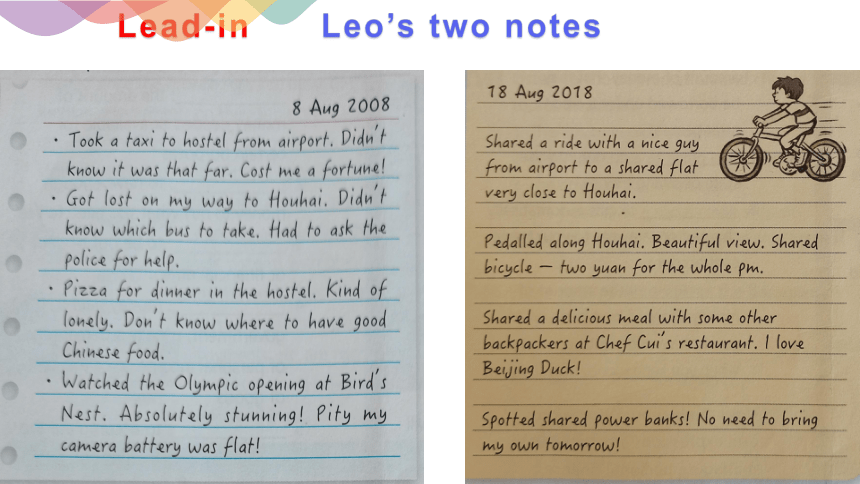
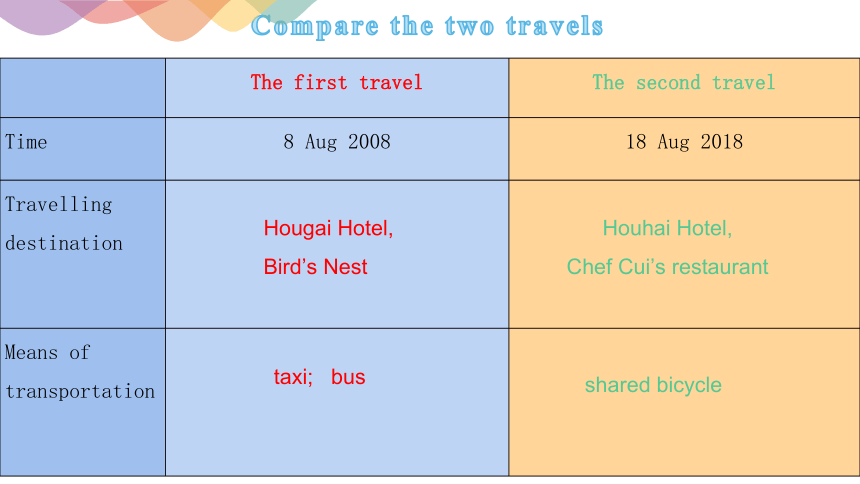
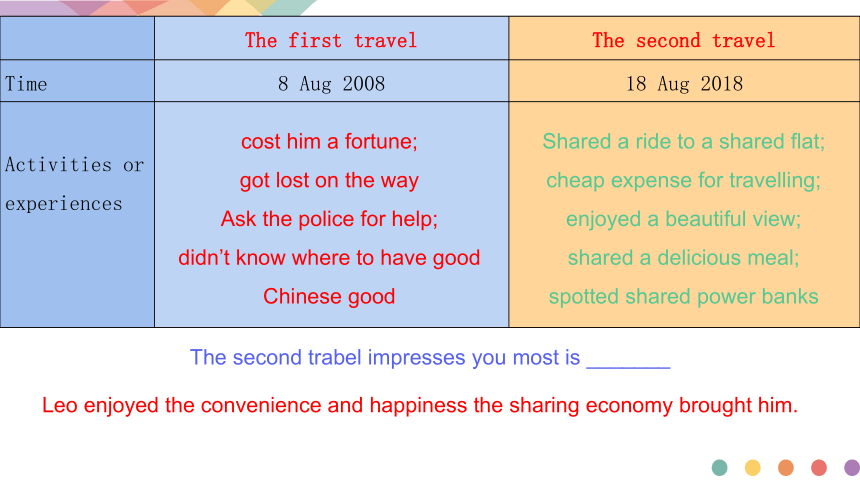
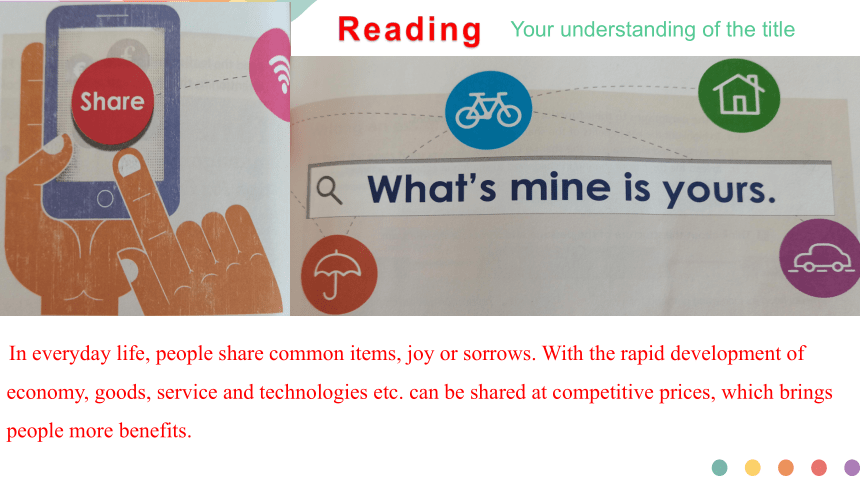
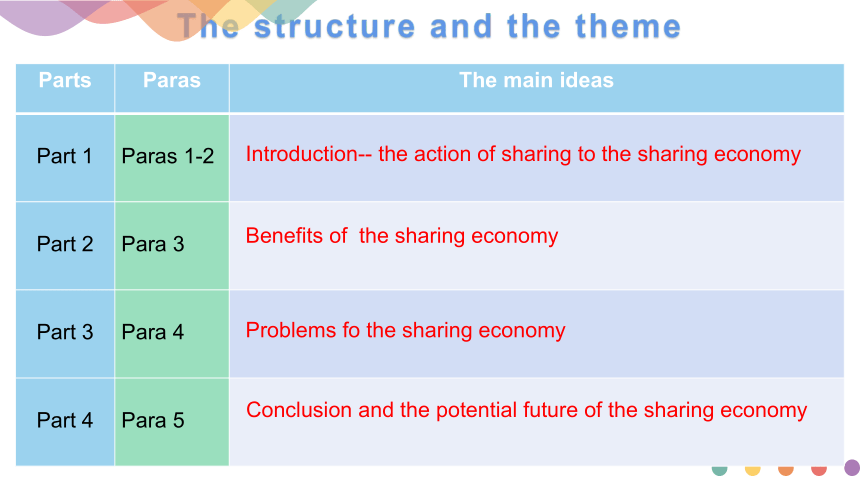
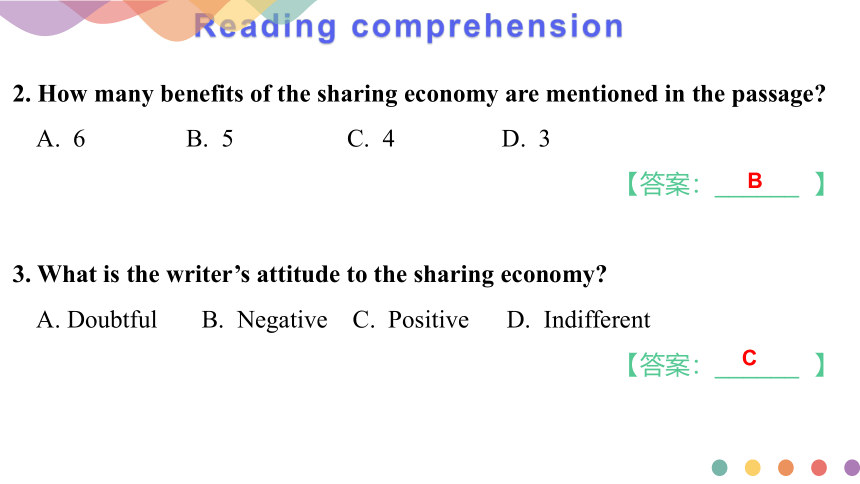
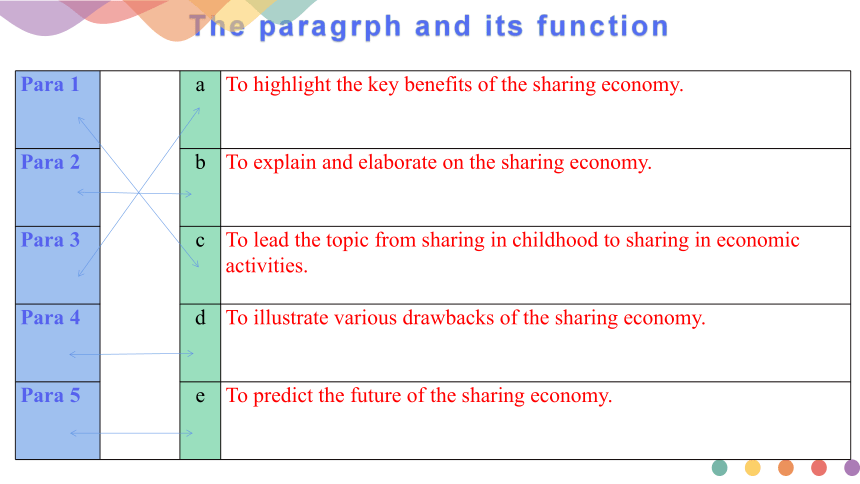
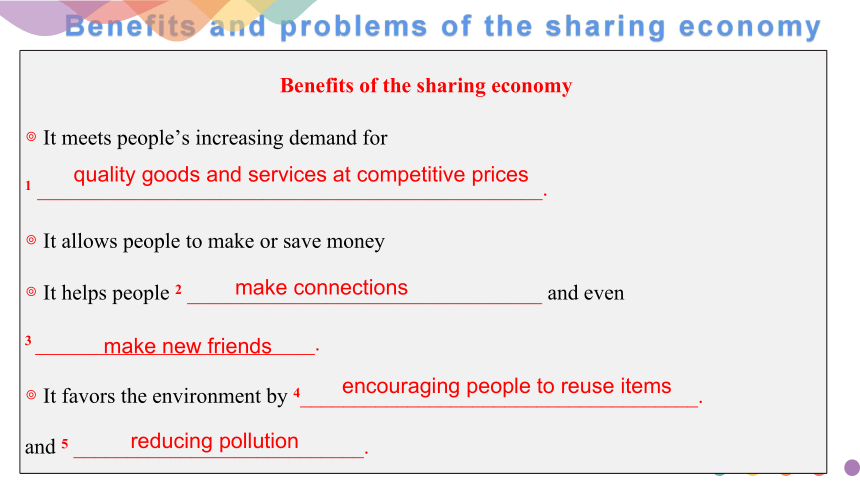
文档简介
(共29张PPT)
外研版(2019)高中英语 选择性必修第四册
Unit 4 Everyday economics
Period 3 Developing ideas & Presenting ideas
Lead-in Leo’s two notes
Compare the two travels
The first travel The second travel
Time 8 Aug 2008 18 Aug 2018
Travelling destination
Means of transportation
Hougai Hotel,
Bird’s Nest
Houhai Hotel,
Chef Cui’s restaurant
taxi; bus
shared bicycle
The first travel The second travel
Time 8 Aug 2008 18 Aug 2018
Activities or experiences
The second trabel impresses you most is _______
cost him a fortune;
got lost on the way
Ask the police for help;
didn’t know where to have good Chinese good
Shared a ride to a shared flat; cheap expense for travelling; enjoyed a beautiful view;
shared a delicious meal;
spotted shared power banks
Leo enjoyed the convenience and happiness the sharing economy brought him.
Reading
Your understanding of the title
In everyday life, people share common items, joy or sorrows. With the rapid development of economy, goods, service and technologies etc. can be shared at competitive prices, which brings people more benefits.
The structure and the theme
Parts Paras The main ideas
Part 1 Paras 1-2
Part 2 Para 3
Part 3 Para 4
Part 4 Para 5
Introduction-- the action of sharing to the sharing economy
Benefits of the sharing economy
Problems fo the sharing economy
Conclusion and the potential future of the sharing economy
Reading comprehension
2. How many benefits of the sharing economy are mentioned in the passage
A. 6 B. 5 C. 4 D. 3
【答案:______ 】
3. What is the writer’s attitude to the sharing economy
A. Doubtful B. Negative C. Positive D. Indifferent
【答案:______ 】
B
C
The paragrph and its function
Para 1 a To highlight the key benefits of the sharing economy.
Para 2 b To explain and elaborate on the sharing economy.
Para 3 c To lead the topic from sharing in childhood to sharing in economic activities.
Para 4 d To illustrate various drawbacks of the sharing economy.
Para 5 e To predict the future of the sharing economy.
Benefits and problems of the sharing economy
Benefits of the sharing economy
◎ It meets people’s increasing demand for
1 _______________________________________________.
◎ It allows people to make or save money
◎ It helps people 2 _________________________________ and even
3 __________________________.
◎ It favors the environment by 4_____________________________________.
and 5 ___________________________.
quality goods and services at competitive prices
make connections
make new friends
encouraging people to reuse items
reducing pollution
Benefits and problems of the sharing economy
Problems of the sharing economy
◎ The sharing economy is developing faster than
6 ___________________________________________
◎ The sharing economy is subject to 7 _____________________.
◎ Personal information about 8 _________________________________.
is 9 ________________________ in the sharing economy.
existing regulations or ongoing supervision
abuse of trust
almost every part of our lives
not yet secure
Post reading
Talk about the future of the sharing economy
What will happen in the next 20 years as the world’s economy becomes ever more global and digital. Consider the following:
◎ What will people be sharing next
◎ How will they be sharing these things
◎ What benefits will people get from sharing these things
The future of the sharing economy
As far as I know, with the the world’s economy becoming more global and digital, sharing economy will exceed earlier items from the shared vehicles, to shared housing, parking spaces, household tools. Sharing clothing, and even the sharing of land planting are on the way.
Due to knowledge, data, resources and other contents, driven by Internet plus, the coverage of the sharing economy is becoming wider and richer, and cooperative contents have been formed, such as massive data management, mobile communication, and social media
Sharing economy in different fields will inevitably impact the traditional development model in these fields.
Think & Share
1. What is the author’s attitude towards the sharing economy
2. What do you think are other benefits and problems of the sharing economy How could we address the potential problems
The author acknowledges the benefits of the sharing economy, but he takes concern about the problems as well as is curoius about the future of the sharing economy.
Sharing economy will y new problems and challenges such as making the traditional enterprise face the huge competition pressure, the redistribution of social wealth and benefits and so on.
Part 2 Writing
Read the posts from an online forum.
Posts from web users
the structure of an essay about non-cash payments
Definition of non-cash payments
Benefits
No cash is involved when people are making their payments, mobile phones and other electronic devices.
Convenient and fast. Do not need to carry lots of heavy coins or duty notes. No more worries about losing wallets.
Problems
Conclusion
Not safe enough and may lead to over-consumption. Some forms of electronic payments are restricted to the Internet. Potential inconvenience exists if the phone battery dies. Some forms are unfriendly to those who don’t know how to use electronic payments, especially the elderly.
Non-cash payments, or electronic payments brings us lots of advantages. However, the disadvantages can’t be ignored. Maybe we could try to use money less., rather than replacing it with non-cash payments for ever. Meanwhile, we need to think of ways to make non-cash payments better, friendier and more scientific.
Possible version
Para 1-- Definition: Nowadays, non-cash payments are becoming more and more popular across the world, especially in China. It refers to the method of making payments with cards, mobile phones and other electronic devices. New ways of supporting non-cash payments are quickly turning up one after another.
Para 2 --Benefits: Obviously, there are benefits. First, they are so convenient and fast that people could make almost all the payments with a single click on the phones. In some shopping centers, they can pay by simply standing in front of a camera adn let it recognize their faces. Second, non-cash payments are safe and hygienic. They free people from carrying heavy coins and dirty notes, or even a wallet. Therefore, the risk of losing money or the wallet is not a threat any more. What’s more, non-cash payments eliminate the risk of counterfeit money.
However, the problems that accompany non-cash payments should not be ignored. It is not as safe as people assumed, as it is not hard for hackers to access people’s bank accounts and steal the money. Also, your personal information is easy to be stolen. Meanwhile, non-cash payments may encourage over-consumption. They also depend too much on the Internet access or battery capacity--just imagine being at a place with no wifi and a flat battery. Last but not least, non-cash payments are not quite friendly with people not knowing how, especially the elderly. It’s such a pity to make them feel excluded and left out.
Para 3 Problems
Para 4 Conlusion
Nonetheless, non-cash payments are increasingly payt of our fast-growing modern society. The current trend is for more non-cash payments in future. But embracing a new trend doesn’t means to exclude the “old-fashioned” ways. Perhaps it is more convenient for people-- to have various options, in both cash and non-cash forms, when it comes to making payments, for the better good.
Part 3 Presenting ideas
A city is booming as its high-tech sector develops fast, which wins the city a nickname--a new “Silicon Valley”.
What is the headline about
The local economy has been given new life by traditional crafts.
Eco-tourism is now the largest and most valuable sector of the local economy.
How to promote economic development in your home town
a Your goals--
b Your plan --
c Your measures and your action--
Sellers of farm products who are located in
remote areas are using e-commerce to grow
their businesses.
Language appreciation
1. 1. This wealth of ways of sharing is a response to our increasing demand for quality goods and services at competitive prices, all delivered at the click of a button.
[句式分析]
“all delivered at the click of a button” 是独立主格结构,在句子中作状语;其中动词deliver 与其逻辑主语构成 被动 语态关系,故使用 过去 分词。
[尝试翻译]
这种丰富的分享方式对我们日益增长的需要的一种回应,即以有竞争力的价格提供优质商品和服务。
Language appreciation
2. What’s more, sharing encourages us to reuse items, thereby cutting down on waste.
[句式分析]
“thereby cutting down on waste. ”为现在分词短语作结果状语,其中thereby 是副词,意为“因此”,所给动词短语cut down与前面句子整体意义构成 主动 关系,故使用 现在 分词。
[尝试翻译]
更重要的是,分享鼓励我们重复使用物品,从而减少浪费。
Language appreciation
3. Nonetheless, what is in no doubt is that the sharing economy is increasingly relevant to our daily lives as well as to the global economy.
[句式分析]
整个句子构成主系表结构。其中“ what is in no doubt ”是what引导的 主语 从句,引导词what充当主语从句的 主语 ; “that the sharing economy is....” 是that引导的 表语 从句。
[尝试翻译]
然而,毫无疑问的是,共享经济日益与我们的日常生活以及全球经济息息相关。
Language points
1 remind sb to do sth 8
as is often the case
2 be beneficial to ... 9
take advantage of ...
3 take on 10
at the expense of ...
4 be into sth 11
be subject to...
5 a response to sth 12
be relevant to...
6 rent out 13
do sb a favour
7 cut down 14
desinger clothes
Assignments for this period
1. Review new words , phrases and useful expressions learned in this period.
2. Think back about the what a two-sided argumentative essay is.
3. Polish your writing-- an essay about non-cash payments.
感谢您的观看
外研版(2019)高中英语 选择性必修第四册
Unit 4 Everyday economics
Period 3 Developing ideas & Presenting ideas
Lead-in Leo’s two notes
Compare the two travels
The first travel The second travel
Time 8 Aug 2008 18 Aug 2018
Travelling destination
Means of transportation
Hougai Hotel,
Bird’s Nest
Houhai Hotel,
Chef Cui’s restaurant
taxi; bus
shared bicycle
The first travel The second travel
Time 8 Aug 2008 18 Aug 2018
Activities or experiences
The second trabel impresses you most is _______
cost him a fortune;
got lost on the way
Ask the police for help;
didn’t know where to have good Chinese good
Shared a ride to a shared flat; cheap expense for travelling; enjoyed a beautiful view;
shared a delicious meal;
spotted shared power banks
Leo enjoyed the convenience and happiness the sharing economy brought him.
Reading
Your understanding of the title
In everyday life, people share common items, joy or sorrows. With the rapid development of economy, goods, service and technologies etc. can be shared at competitive prices, which brings people more benefits.
The structure and the theme
Parts Paras The main ideas
Part 1 Paras 1-2
Part 2 Para 3
Part 3 Para 4
Part 4 Para 5
Introduction-- the action of sharing to the sharing economy
Benefits of the sharing economy
Problems fo the sharing economy
Conclusion and the potential future of the sharing economy
Reading comprehension
2. How many benefits of the sharing economy are mentioned in the passage
A. 6 B. 5 C. 4 D. 3
【答案:______ 】
3. What is the writer’s attitude to the sharing economy
A. Doubtful B. Negative C. Positive D. Indifferent
【答案:______ 】
B
C
The paragrph and its function
Para 1 a To highlight the key benefits of the sharing economy.
Para 2 b To explain and elaborate on the sharing economy.
Para 3 c To lead the topic from sharing in childhood to sharing in economic activities.
Para 4 d To illustrate various drawbacks of the sharing economy.
Para 5 e To predict the future of the sharing economy.
Benefits and problems of the sharing economy
Benefits of the sharing economy
◎ It meets people’s increasing demand for
1 _______________________________________________.
◎ It allows people to make or save money
◎ It helps people 2 _________________________________ and even
3 __________________________.
◎ It favors the environment by 4_____________________________________.
and 5 ___________________________.
quality goods and services at competitive prices
make connections
make new friends
encouraging people to reuse items
reducing pollution
Benefits and problems of the sharing economy
Problems of the sharing economy
◎ The sharing economy is developing faster than
6 ___________________________________________
◎ The sharing economy is subject to 7 _____________________.
◎ Personal information about 8 _________________________________.
is 9 ________________________ in the sharing economy.
existing regulations or ongoing supervision
abuse of trust
almost every part of our lives
not yet secure
Post reading
Talk about the future of the sharing economy
What will happen in the next 20 years as the world’s economy becomes ever more global and digital. Consider the following:
◎ What will people be sharing next
◎ How will they be sharing these things
◎ What benefits will people get from sharing these things
The future of the sharing economy
As far as I know, with the the world’s economy becoming more global and digital, sharing economy will exceed earlier items from the shared vehicles, to shared housing, parking spaces, household tools. Sharing clothing, and even the sharing of land planting are on the way.
Due to knowledge, data, resources and other contents, driven by Internet plus, the coverage of the sharing economy is becoming wider and richer, and cooperative contents have been formed, such as massive data management, mobile communication, and social media
Sharing economy in different fields will inevitably impact the traditional development model in these fields.
Think & Share
1. What is the author’s attitude towards the sharing economy
2. What do you think are other benefits and problems of the sharing economy How could we address the potential problems
The author acknowledges the benefits of the sharing economy, but he takes concern about the problems as well as is curoius about the future of the sharing economy.
Sharing economy will y new problems and challenges such as making the traditional enterprise face the huge competition pressure, the redistribution of social wealth and benefits and so on.
Part 2 Writing
Read the posts from an online forum.
Posts from web users
the structure of an essay about non-cash payments
Definition of non-cash payments
Benefits
No cash is involved when people are making their payments, mobile phones and other electronic devices.
Convenient and fast. Do not need to carry lots of heavy coins or duty notes. No more worries about losing wallets.
Problems
Conclusion
Not safe enough and may lead to over-consumption. Some forms of electronic payments are restricted to the Internet. Potential inconvenience exists if the phone battery dies. Some forms are unfriendly to those who don’t know how to use electronic payments, especially the elderly.
Non-cash payments, or electronic payments brings us lots of advantages. However, the disadvantages can’t be ignored. Maybe we could try to use money less., rather than replacing it with non-cash payments for ever. Meanwhile, we need to think of ways to make non-cash payments better, friendier and more scientific.
Possible version
Para 1-- Definition: Nowadays, non-cash payments are becoming more and more popular across the world, especially in China. It refers to the method of making payments with cards, mobile phones and other electronic devices. New ways of supporting non-cash payments are quickly turning up one after another.
Para 2 --Benefits: Obviously, there are benefits. First, they are so convenient and fast that people could make almost all the payments with a single click on the phones. In some shopping centers, they can pay by simply standing in front of a camera adn let it recognize their faces. Second, non-cash payments are safe and hygienic. They free people from carrying heavy coins and dirty notes, or even a wallet. Therefore, the risk of losing money or the wallet is not a threat any more. What’s more, non-cash payments eliminate the risk of counterfeit money.
However, the problems that accompany non-cash payments should not be ignored. It is not as safe as people assumed, as it is not hard for hackers to access people’s bank accounts and steal the money. Also, your personal information is easy to be stolen. Meanwhile, non-cash payments may encourage over-consumption. They also depend too much on the Internet access or battery capacity--just imagine being at a place with no wifi and a flat battery. Last but not least, non-cash payments are not quite friendly with people not knowing how, especially the elderly. It’s such a pity to make them feel excluded and left out.
Para 3 Problems
Para 4 Conlusion
Nonetheless, non-cash payments are increasingly payt of our fast-growing modern society. The current trend is for more non-cash payments in future. But embracing a new trend doesn’t means to exclude the “old-fashioned” ways. Perhaps it is more convenient for people-- to have various options, in both cash and non-cash forms, when it comes to making payments, for the better good.
Part 3 Presenting ideas
A city is booming as its high-tech sector develops fast, which wins the city a nickname--a new “Silicon Valley”.
What is the headline about
The local economy has been given new life by traditional crafts.
Eco-tourism is now the largest and most valuable sector of the local economy.
How to promote economic development in your home town
a Your goals--
b Your plan --
c Your measures and your action--
Sellers of farm products who are located in
remote areas are using e-commerce to grow
their businesses.
Language appreciation
1. 1. This wealth of ways of sharing is a response to our increasing demand for quality goods and services at competitive prices, all delivered at the click of a button.
[句式分析]
“all delivered at the click of a button” 是独立主格结构,在句子中作状语;其中动词deliver 与其逻辑主语构成 被动 语态关系,故使用 过去 分词。
[尝试翻译]
这种丰富的分享方式对我们日益增长的需要的一种回应,即以有竞争力的价格提供优质商品和服务。
Language appreciation
2. What’s more, sharing encourages us to reuse items, thereby cutting down on waste.
[句式分析]
“thereby cutting down on waste. ”为现在分词短语作结果状语,其中thereby 是副词,意为“因此”,所给动词短语cut down与前面句子整体意义构成 主动 关系,故使用 现在 分词。
[尝试翻译]
更重要的是,分享鼓励我们重复使用物品,从而减少浪费。
Language appreciation
3. Nonetheless, what is in no doubt is that the sharing economy is increasingly relevant to our daily lives as well as to the global economy.
[句式分析]
整个句子构成主系表结构。其中“ what is in no doubt ”是what引导的 主语 从句,引导词what充当主语从句的 主语 ; “that the sharing economy is....” 是that引导的 表语 从句。
[尝试翻译]
然而,毫无疑问的是,共享经济日益与我们的日常生活以及全球经济息息相关。
Language points
1 remind sb to do sth 8
as is often the case
2 be beneficial to ... 9
take advantage of ...
3 take on 10
at the expense of ...
4 be into sth 11
be subject to...
5 a response to sth 12
be relevant to...
6 rent out 13
do sb a favour
7 cut down 14
desinger clothes
Assignments for this period
1. Review new words , phrases and useful expressions learned in this period.
2. Think back about the what a two-sided argumentative essay is.
3. Polish your writing-- an essay about non-cash payments.
感谢您的观看
